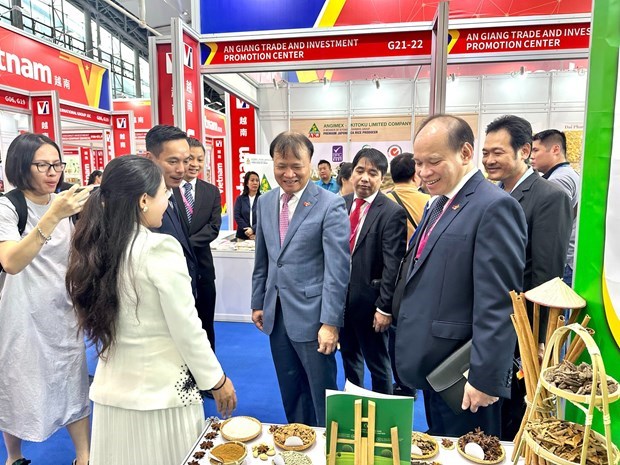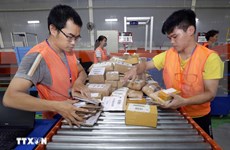Market share of Vietnamese goods increasing in distribution channels

Vietnamese goods on display at a trade fair. (Photo: VietnamPlus)
Hanoi (VNA) – Good quality, beautiful designs, and reasonable prices are reasons that make Vietnamese products, especially consumer goods and agricultural products prominent in the domestic market.
In recent times, despite fierce competitive pressure from imported products, Vietnamese products have increasingly dominated the domestic market.
Nguyen Bich Van, head of communications at Central Retail in Vietnam said that the group appreciates the role of Vietnamese goods in the commodity structure of its supermarket system. Currently, Vietnamese goods account for over 90% of the total 45,000 product codes sold at the Big C supermarket system.
Nguyen Thi Kim Dung, Director of Co.opmart Hanoi supermarket in Ha Dong district said that for many years, Saigon Co.op, which manages the supermarket network Co.opmart, Co.op Food, and Co.opXtra, always prioritizes Vietnamese goods. In addition, Saigon Co.op also coordinates with localities to provide capital and technical support for suppliers to invest in producing high-quality products for the Co.opmart system.
Meanwhile, at AEON Vietnam supermarkets, Vietnamese products account for about 80% of total products. Particularly, just 5-10% of fresh food in the supermarkets are imported.
 Vietnamese products are available in distribution channels. (Photo: VietnamPlus)
Vietnamese products are available in distribution channels. (Photo: VietnamPlus)At the WinMart/WinMart+ supermarket chain, the proportion of Vietnamese goods is always maintained at 80-90% of the quantity and type of goods.
Le Viet Nga, Deputy Director of the Domestic Market Department under the Ministry of Industry and Trade said that currently, the domestic market has organised networks to supply goods to 100 million Vietnamese people.
In particular, after the Domestic Market Development Strategy to 2023 with a vision to 2045 was approved, the modernisation of commercial infrastructure in the domestic market has received great attention.
"Many foreign businesses are registering to invest in Vietnam as well as open goods supply chains in the country. Many foreign retail businesses are very interested in supporting the consumption of goods in the country,” Nga said.
Yol Phokasub, CEO of Central Retail Corporation said that in the next five years, the corporation will continue to expand its business activities, meeting the growth trend of the economy. It aims to double the number of stores and expand its network in Vietnam's localities in the next four years.
Similarly, in its long-term strategy, AEON Group identifies Vietnam as the second key market after Japan, to boost investment. Accelerating the expansion of new retail models is one of the three development focuses of the Japanese retailers in 2023. To maximize convenience as a priority and the change in post-pandemic shopping trends of customers, AEON Vietnam will continue to develop, expand, and diversify retail models that are flexible in scale, and suitable to the needs and actual conditions of each locality.
Furusawa Yasuyuki, General Director of AEON Vietnam, said AEON will continue to focus on increasing the number of large shopping centres. At the same time, to meet changes in customer needs, the company will test new models such as medium-sized supermarkets, and small-scale supermarkets with the MaxValu brand.
In addition, AEON Vietnam also promotes the development of private label products manufactured in Vietnam and meeting AEON standards to provide customers with quality products at reasonable prices, contributing to stabilising the supply chain and support to improve the capacity of suppliers.

Consumers buy goods with guaranteed origin and quality. (Photo: VietnamPlus)
Meanwhile, according to Tran Thi Phuong Lan, Acting Director of the Hanoi Department of Industry and Trade, to affirm their position in the domestic market while opening up many opportunities for Vietnamese goods, businesses also need to step up investment. They need to move forward and apply advanced technology, improve management capabilities on digital technology models through e-commerce, increase labour productivity, and lower costs.
However, it’s still a must to ensure quality and diverse designs to meet the diverse and increasing shopping needs of consumers.
Lan also recommended that businesses should further provide consumers with information about standards and quality of goods and services./.












